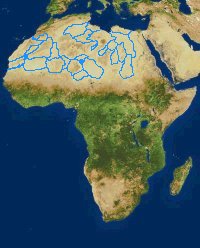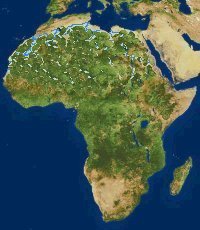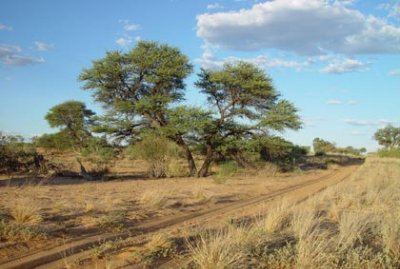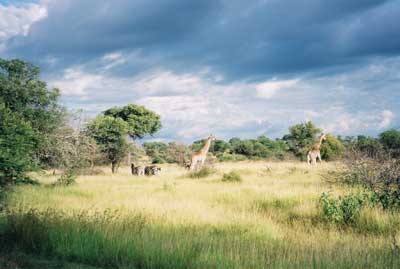 Since the time of Victorian England, there have been thoughts and plans to stop the death of the African flora and fauna and to restore the Sahara and north African deserts to a more viable biotope.
Since the time of Victorian England, there have been thoughts and plans to stop the death of the African flora and fauna and to restore the Sahara and north African deserts to a more viable biotope.
Basically, the plan is to build networks of canals from the Atlantic Ocean and the Mediterranean Sea to bring water from the sea into the interior. There are several possible low cost & low maintenance desalinisation methods, such as graded marshland and canvas sheets, that could convert the sea water to fresh water along the route.
Most importantly, whether the water in the canals is salty or fresh, it will evaporate into the air as fresh water. This evaporated moisture in the air around the canals will collect as dew and mist. This will provide moisture for small plants growing in the vicinity. As the canals become more developed and networked, they will enable larger cloudy areas which will in turn form fog, mist and light rains in the region.
 Immediately, this effort will start to bring economic relief to the people in the area.
The work on the canals will provide employment for hundreds of thousands of people for decades.
There will also be opportunities for bright young people who are interested in advanced education, since the project will require knowledge and skills in many areas.
There may be opportunities to create new communities with sustainable energy efficient architecture such as fabric, adobe, geodesic and monolithic concrete domes.
Immediately, this effort will start to bring economic relief to the people in the area.
The work on the canals will provide employment for hundreds of thousands of people for decades.
There will also be opportunities for bright young people who are interested in advanced education, since the project will require knowledge and skills in many areas.
There may be opportunities to create new communities with sustainable energy efficient architecture such as fabric, adobe, geodesic and monolithic concrete domes.
Small marine livestock such as fish, eels, turtles and shellfish can be farmed in the canals from the start, providing nutritious food for the people and populating the area with helpful wildlife. There are many fruits and vegetables that can be grown in and near salty and brackish water (dulse, kelp, salicornia, coconut, etc). The fresh water areas will enable the farming of frogs and freshwater fish. As the freshwater canals become established, crocodiles and hippopotamus may be re-introduced to the area, since they will be helpful in the maintainance of the canals.
 The micro-climate of the canals will enable small plants to grow from the banks of the canals outward, restoring the ability of the deserted areas to support life.
This in turn will expand the area of moistened air.
Insects, bees and birds will be able to return. This will dramatically help to restore the agriculture.
With plants growing in the area, the larger animals will be able to return.
Gradually, the people and animals in the area will help to re-fertilise the soil.
Trees will be able to grow again in the region.
The micro-climate of the canals will enable small plants to grow from the banks of the canals outward, restoring the ability of the deserted areas to support life.
This in turn will expand the area of moistened air.
Insects, bees and birds will be able to return. This will dramatically help to restore the agriculture.
With plants growing in the area, the larger animals will be able to return.
Gradually, the people and animals in the area will help to re-fertilise the soil.
Trees will be able to grow again in the region.
 Over time, the entire area will change from a deserted land to a healthy savannah and plains meadow biotope.
When the crocodiles, hippos, lions, cheetah, rhinos and elephants can return, it will be a sign that the deserted areas are being healed and well on the way back to a normal healthy land.
Once large areas are covered with grasses, bushes and trees, the solar heat will not be reflected into the air and the clouds will return over the land.
When the clouds reach the mountains, snow will collect at the tops and mountain streams will form, indicating a complete and healthy water cycle.
Over time, the entire area will change from a deserted land to a healthy savannah and plains meadow biotope.
When the crocodiles, hippos, lions, cheetah, rhinos and elephants can return, it will be a sign that the deserted areas are being healed and well on the way back to a normal healthy land.
Once large areas are covered with grasses, bushes and trees, the solar heat will not be reflected into the air and the clouds will return over the land.
When the clouds reach the mountains, snow will collect at the tops and mountain streams will form, indicating a complete and healthy water cycle.
The restoration of northern Africa to a healthy life-supporting condition will also contribute greatly to the restoration of the atmosphere. The trees and plants that will cover the northern half of the continent will be have a tremendously beneficial effect on the world wide climate.
These benefits can be identified:
- Creation of important work for millions of people.
- Reduction of African and worldwide poverty & starvation.
- Creation of another 'breadbasket' region for the world.
- Opportunities for advanced education in Africa.
- Creation of new well-designed cities for millions of people.
- Increased contributions to the African and world economies.
- Restoration and protection of wildlife populations in Africa.
- Dramatic reduction of the threat of global warming.